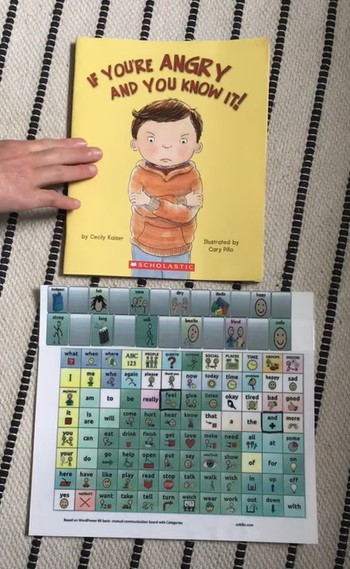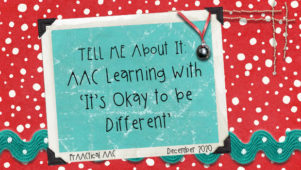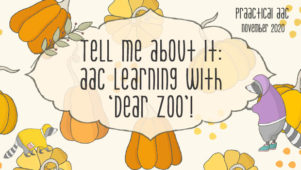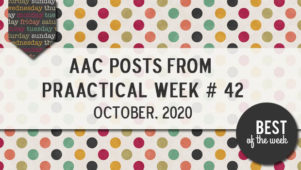TELL ME About It: AAC Learning with ‘If You’re Angry & You Know It’
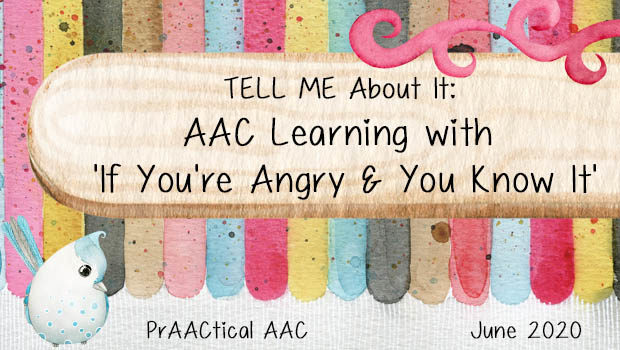
Welcome to a new edition of TELL ME ABout It, a series looking at ways to use children’s trade books to build AAC core vocabulary and literacy skills. Maggie Judson and Jeanna Antrim are back with more great ideas for AAC intervention, this time focusing on the book, ‘If You’re Angry and You Know It.’ Maggie and Jeanna are speech-language pathologists who work in the Assistive Technology Department for the Belleville Area Special Services Cooperative (BASSC) in central Illinois. They are AT/AAC facilitators and provide evaluations, direct therapy, consultations, and trainings.
You can see their previous posts in the TELL ME About It series below.
- The Lunch Box Surprise
- Come Out and Play, Little Mouse
- No, David
- Go Away Big Green Monster
- What Do You Like?
- Here Are My Hands
- From Head to Toe
- I Went Walking
- Brown Bear, Brown Bear
- TELL ME AAC Literacy Kits
Don’t miss their videos using aided language input with communication boards from some popular AAC systems toward the end of this post.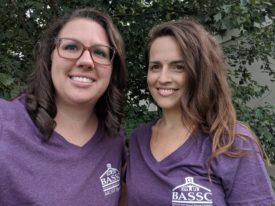
——————————————————-
TELL ME About It: AAC Learning with ‘If You’re Angry and You Know It’!
TELL ME About Reading: The tenth book in the TELL ME program (Teaching Early Language and Literacy through Multimodal Expression) is “If You’re Angry and You Know It.” We love this book as the rhythm and lyrics of the story follow the familiar chant of an often-used song in the preschool classroom, “If You’re Happy and You Know It.” Books that use a familiar format can be motivating for students because they are predictable, making it easy to follow along and participate. Also, stories that can be chanted or sung make for repeated readings that are super fun and entertaining! Other things we love about this book – repeated lines, actions to imitate (three cheers for movement!), and all those core words!
Check out below for the book focus of “If You’re Angry and You Know It”:
Book Focus: If You’re Angry and You Know It
- Core Words (BOW WOW Words): AND, ANGRY/MAD, FOOT/FEET, WALK, SHOW
- Additional Words (Tiger Talk Words): know, feel
- Concept Vocabulary: feelings and actions
- Special Letter: g
- Book Concept: front vs. back
TELL ME About Writing: Why include daily writing activities and instruction in early childhood/preschool classrooms? Why is this so important when students are still working on developing their language and communication skills? Great questions! Let’s break it down!
Communication and literacy skills are interdependent and impact one another. This means growth in literacy skills will positively impact communication skills, yay! However, this interconnection also means that by keeping one of these things out of instruction (i.e., writing), the other areas (i.e., receptive and expressive language) may not develop as fully as they would if you were to address all parts. So by incorporating writing instruction into the preschool classroom = working on literacy AND communication skills!
Additionally, according to Gabas et al (2019), students with language delays may also experience emergent literacy delays, which can persist over time. Addressing literacy skills, including writing, in the preschool classroom can help to address these literacy delays early on in the student’s educational career. “Preschoolers’ exposure to and participation in literacy-enriched activities are crucial for building and strengthening their emergent literacy skills” (Gabas, et al, 2019, pg. 168).
With that in mind let’s jump into today’s writing lesson!
- Before Writing: Review, review, review! The ‘before writing’ lesson is all about reviewing the target core words and the chart title. Continue the say-and-repeat review of the story core words WALK, AND, ANGRY/MAD, FOOT/FEET, and SHOW one by one, using word/symbol cards. Then review the chart title by reading it out loud while pointing to each word as you do – “NOW, let’s READ our title. IT is, ‘MY FEELINGS!’ ”
- Writing: Take the completed chart or the PowerPoint book you finished in previous lessons and clap out those sentences! As you read each sentence, support students to clap, stomp, tap, or say each word in their head as you read it. Follow that up with a core word hunt in the chart – have students take turns finding the story core words AND, ANGRY/MAD, FOOT/FEET, WALK, SHOW. Finish up with some special letter work! Look through the chart for the letter ‘g,’ highlighting it and talking about its name and its sounds.
- After Writing: Finish up today’s writing lesson with the Letter Song (“every letter makes a sound…”) and work in some fun letter activities, such as letter stamping, letter crayon rubbing, letter hunting in a sensory bag or bin, or letter fishing! These activities are great for drawing attention to print and providing additional exposure to the special letter, its name, and its sounds.
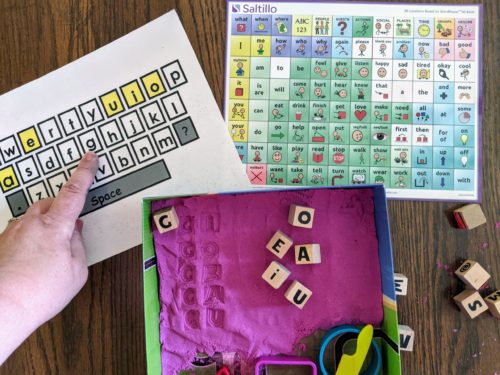
TELL ME More: Below are some specific ideas on how to implement “If You’re Angry and You Know It” in your therapy sessions and classrooms TELL ME-style!
- Activity – Alphabet Book!
One activity that we always hear positive feedback about is the Alphabet Books! Our teams absolutely LOVE this activity! Students typically enjoy being able to go on a scavenger hunt or ‘letter walk’ to find objects or pictures that start with the letter of the day or week. An additional must-have to the paper alphabet book printable is a manual communication and alphabet board. This way, you can communicate and discriminate between letters on-the-go! 
- “SHOW me the picture that starts with ‘G’ “.
- “Let’s take a WALK AND see what letters we KNOW.”
- “You wrote G is for grass AND G is for green!”
Our teams love these so much, we have created an Alphabet Book for each letter! A link to all 26 books is here .
- Teaching Strategy – Letter-Sound Correspondence Activities!
According to Dr. Karen Erickson (2017), one of the goals of emergent literacy instruction includes alphabetic and phonological awareness, which explain why a critical component to the TELL ME program is infusing letter-sound correspondence learning throughout the day. While this is addressed for the special letter each day in the writing lesson, other activities can easily be incorporated to work in extra practice!
- Sing a fun name song during morning circle time! Sing the “Bingo Was His Name-O” song using the names of the students – “I like to say good morning to a friend I like a lot, oh! D-A-V-E-Y, D-A-V-E-Y, D-A-V-E-Y, and ‘Davey’ is his name, oh!”. You can alternate saying the letter names and saying the letter sounds each time you sing it!
- Role-Playing with the special letter! Students can role-play professions that begin with the letter g: Gardener, Garbage Collector, Guitarist, Grocer, Governor – “We are going to pretend to be people that start with the letter g.” Extra points if you provide props and costumes!
- Add in some explicit practice! Show a letter card and say the letter’s sound a few times. Then include this letter card with a few others displayed to the student. Say the target sound and have the child select the corresponding letter card, providing support as needed. Allow him or her to practice this a few times!
- Implementation Tip – Family Involvement!
One of the (many!) things we love about the TELL ME program is its focus on family involvement. Involving families ensures that the skills practiced at school in the classroom are reinforced at home and in the community, helping to promote carryover and generalization. Each book packet includes home extension activity ideas and a Share Packet full of ways families can carry over the TELL ME week in their daily routines. We also recommend sending home the crafts and letter books each week so families can review these activities and get a first-hand idea about some of the different skills their child is working on!
Another related component of family involvement is asking for consistent feedback from caregivers. This type of information is important because:
- It can help us as educators guide our instruction in the classroom
- It provides insight into what types of support families may benefit from to be successful at home
- It keeps the lines of communication open and provides a platform for families to ask questions regularly
The TELL ME program provides a great family report checklist that can be used weekly! 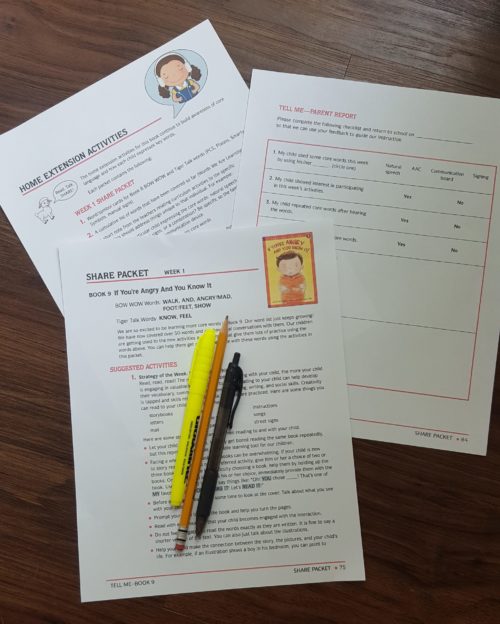
- Aided Language Input Tip – Self Talk: Feelings and Needs!
In previous posts, we have discussed the importance of self-talk and verbal referencing. Using these instructional strategies to talk about feelings and emotions is a natural fit with the book “If You’re Angry and You Know It”! It is essential for us as communication partners to show our students how to label and talk about emotions. This book provides the perfect opportunity to hone in on these key features of Aided Language Input while discussing our feelings and different strategies to help manage emotional responses.
- “I FEEL ANGRY. I need to take a WALK.”
- “I am MAD. I need a break.”
- “My FEET hurt. SHOW me where I can sit down.”
- Goal Ideas – Providing shared reading and writing opportunities directly relates to IEP goals, as these activities align with various core standards. Here are some examples you may find applicable:
- ELA-Literacy.RF.K.3d: Distinguish between similarly spelled words by identifying the sounds of the letters that differ.
- ELA-Literacy.RF.K.2d: Isolate and pronounce the initial, medial vowel, and final sounds (phonemes) in three-phoneme (consonant-vowel-consonant, or CVC) words.* (This does not include CVCs ending with /l/, /r/,or /x/.)
———————————————————————————————————————
Be sure to check back next month as we work through the TELL ME manual and share activities, teaching strategies, and implementation tips for the next book in the program, “Max’s Breakfast”!
Check out the videos of us reading the book “If You’re Angry and You Know It” while providing aided language input using various communication boards.
Direct link to video –https://www.youtube.com/watch?v=SgFRWyEWNeA&t=1s
Snap Core First Communication Board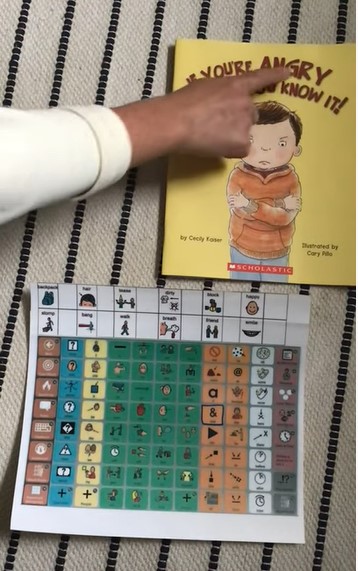
Direct link to video –https://www.youtube.com/watch?v=gdXkuyhsbvU
LAMP Words for Life Communication Board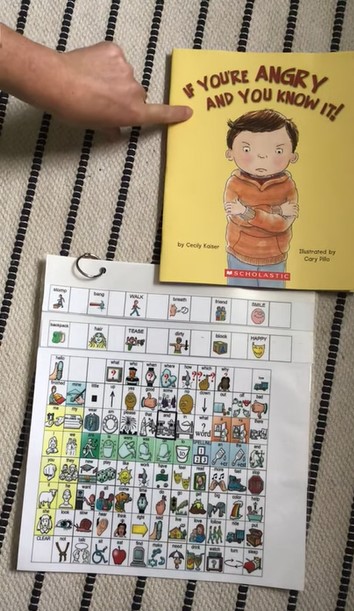
Direct link to video – https://www.youtube.com/watch?v=gDFRKSAEP7w
RESOURCES and REFERENCES:
- Erickson, K. (2017). Comprehensive Literacy Instruction, Interprofessional Collaborative Practice, and Students With Severe Disabilities. American Journal of Speech-Language Pathology, 26, 193-205. doi:10.1044/2017_AJSLP-15-0067
- Gabas, C., Marante, L., & Cabell S. (2019). Fostering Preschoolers’ Emergent Literacy: Recommendations for Enhanced Literacy Experiences and Collaborative Instruction. Perspectives of the ASHA Special Interest Groups, 4, 167-176. doi:10.1044/PERS-SIG16-2018-0012
- You can purchase the TELL ME manual from the Attainment Company or from ASHA.
- You can learn more about the program by watching the webinar TELL ME: AAC for the Preschool Classroom presented by Dr. Carole Zangari, available from Saltillo (bit.ly/2RNpykn).
You can find our Lesson Planning form for “If You’re Happy & You Know It” and a blank form here.
Follow us on Instagram @basscAAC and subscribe to our YouTube channel (basscAAC) for more AAC implementation ideas!
Filed under: Featured Posts, PrAACtical Thinking
Tagged With: shared reading, shared writing, TELL ME
This post was written by Carole Zangari
